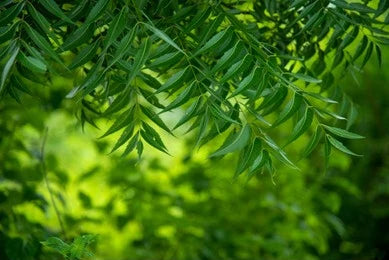Neem is an evergreen tree, but in times of excessive dryness, it may lose nearly all of its leaves. It is the fastest-growing tree, reaching heights of up to 15-20 meters, while older trees can reach heights of up to 35-40 meters. This tree's branches are long, wide, and spreading, and it has a dense roundish crown. The diameter of the crown of an old tree is approximately 15-20 meters. This tree is quite similar to the Chinaberry tree. The tree's trunk is short and straight, measuring roughly 1-2mt in diameter. Simple and opposing leaves are 3-8cm long; immature leaves are reddish to purple in color, while adult leaves are dark green. Auxiliary blooms are small, white, and fragrant, and are clustered in drooping panicles. Individual flowers are around 5-6mm long and 8-11mm broad. The olive-like drupe fruit is oval to spherical in form, smooth, and green when young. The color of the fruit changes to yellow as it ripens, with pulp and seed inside.
General Description
In Ayurveda, the entire plant is used for medicinal purposes. Leaves and bark are excellent blood purifiers and can be used to treat a variety of skin problems. The plant's fruits are carminative, purgative, and emollient. Flowers are a great tonic and are used to cure gastrointestinal problems. This herb's Sanskrit name is arishta, which means "perfect, complete, and imperishable." Nature has provided this plant with a variety of chemical substances used as insecticides and pesticides. This plant's wood is extremely durable and resistant to termites, germs, parasites, and fungi. This wood is used commercially to make doors, carts, yokes, packing boxes, ceiling blocks, and furniture, and it is also utilized in ships and boats. The bark is bitter, astringent, and tonic, and it is used to cure fever, nausea, vomiting, and skin ailments.
In a methane gas plant, neem seed pulp is utilized to produce methane gas. Because of its tannic content, neem bark is used for tanning and dyeing.
This plant contains a variety of chemical compounds, including nimbin, nimbinene, azadirachtol, azadirachtin, azadirachnol, nimbadinol, nimbolide, beta-sistosterol, quceretine, nimbiol, nimcine, and n-hexacosanol.
Classification
- Kingdom - Plantae
- Order - Rutales
- Family - Meliaceae
Habitat
This herb is indigenous to India and can be found in tropical and subtropical sections of the country, as well as Myanmar, Bangladesh, Sri Lanka, and Pakistan. It is found in open grasslands, woods, food plains, and coastal areas across India.
Names
- Latin name - Azadirachta indica
- Common name - Neem, Indian lilac, Nimtree
- Sanskrit name - Pakvakrita, Nimbaka, Arishta
- Assamese name - Neem
- Hindi name - Neem
- Kannada name - Bevu
- Malayalam name - Aryaveppu
- Tamil name - Veppai, Sengumaru
- Telugu name - Vepa
- Marathi name - Kandunimba
- Manipuri name - Neem
- Gujarati name - Dhanujhada, Limbda
- Sinhala name - Kohomba
- Thai name - Sadao
- Urdu name - Neem
- Portuguese name - Nimbo, Margosa
- Persian name - Nib, Neemb
- French name - Margosier, Margousier, Azadriac le l'llnde
- German name - Indischer zedrach
- Nepalese name - Neem
- Myanmar name - Tamar
- Punjabi name - Nihmm
- Sindhi name - Nimm
Ayurvedic properties
|
|
Hindi / Sanskrit |
English |
|
Rasa (Taste) |
Tikta, Kashaya |
Bitter, Astringent |
|
Guna (Physical Property) |
Laghu, Rooksha |
Light, Dry |
|
Virya (Potency) |
Sheeta |
Cold |
|
Vipaka (Post-Digestive Taste) |
Katu |
Pungent |
Effects on Doshas
It balances pitta and Kapha doshas.
|
Charak Samhita |
Sushrut Samhita |
|
|
Practical Uses
- Neem is a powerful herb with antifungal, antibacterial, anti-diabetic, sedative, antiviral, and antihelminthic effects.
- This plant is best utilized to make various medicinal shampoos, soaps, lotions, and balms for skin smoothing and protection against problems such as pimples, acne, wounds, and ulcers.
- It was once believed that patients suffering from chicken pox should sleep on neem leaves to cure the disease.
- All parts of this plant are utilized to create various pharmaceutical formulations for treating a variety of body problems.
- Neem paste is used externally to treat pimples and acne, while neem leaf decoction is used as a blood purifier to remove all pollutants and poisons from the bloodstream.
- Parts of the neem tree are used to make vitamins and treatments for diabetes people.
- Neem tree twigs are used to clean teeth and to cure numerous ailments related with mouth and teeth issues such as gum swelling and bleeding gums.
- Fever is treated with a neem root decoction. Malaria can be treated with neem leaf extract.
- This herb is used to repel numerous pests, insects, mites, and ticks.
- Neem is a herb used to treat vitiated pitta and pitta illnesses such as leprosy, skin diseases, eczema, pruritus, wounds, ulcers, dyspepsia, leucoderma, burning sensation, vomiting, inflammation, and weariness.
- Neem also combats sexually transmitted infections such as gonorrhea, herpes, and candidiasis.
- Neem is used to treat arthritis, inflammation, and joint pain, as well as to reduce swelling.
- It is utilized to balance the kapha and pitta doshas. This plant aggravates vata dosha in the body due to its light qualities.
Part Used
- Roots
- Bark
- Leaves
- Flowers
- Seeds
- Fruits
Dosage
- Decoction - 50-100ml
- Powder - 3-6gms
- Juice - 10-20ml

